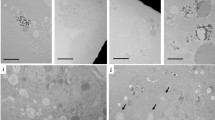Abstract
Extracellular water soluble contrast media, whether gadolinium- or iodine-based, can be removed from the circulation by hemodialysis and less efficiently by peritoneal dialysis. Hemodialysis has no role in prevention of contrast-induced nephropathy and patients on hemodialysis do not need to receive dialysis shortly after administration of iodine-based contrast media. The administration of low stability gadolinium-based contrast media to patients receiving dialysis has been associated with development of nephrogenic systemic fibrosis. Only highly stable gadolinium-based contrast agents at the smallest possible dose should be used if contrast enhanced MR is considered essential in patients receiving dialysis. Patients already on hemodialysis should undergo a hemodialysis session as soon as practically possible after administration of gadolinium-based contrast agents.
Access this chapter
Tax calculation will be finalised at checkout
Purchases are for personal use only
Similar content being viewed by others
References
Brooks MH, Barry KG (1973) Removal of iodinated contrast material by peritoneal dialysis. Nephron 12:10–14
Cruz DN, Perazella MA, Bellomo R et al (2006) Extracorporeal blood purification therapies for prevention of radiocontrast-induced nephropathy: a systematic review. Am J Kidney Dis 48:361–371
Cruz DN, Goh CY, Marenzi G et al (2012) Radiocontrast-induced nephropathy: a systematic review. Am J Med 125:66–78
Dehnarts T, Keller E, Gondolf K et al (1998) Effect of haemodialysis after contrast medium administration in patients with renal insufficiency. Nephrol Dial Transplant 13:358–362
Donally PK, Burwell N, McBurney A et al (1992) Clearance of iopamidol, a non-ionic contrast medium, by CAPD in patients with end-stage renal failure. Br J Radiol 65:1108–1113
Dörsam J, Knopp MV, Schad L et al (1995) Elimination of gadolinium-DTPA by peritoneal dialysis. Nephrol Dial Transplant 10:1228–1230
Furukawa T, Ueda J, Takahashi S, Sajaguchi K (1996) Elimination of low-osmolality contrast media by haemodialysis. Acta Radiol 37:966–971
Huber W, Jeschke B, Kreymann B et al (2002) Haemodialysis for the prevention of contrast-induced nephropathy. Outcome of 31 patients with severely impaired renal function, comparison with patients at similar risk and review. Invest Radiol 37:471–481
Joffe P, Thomsen HS, Meusel M (1998) The pharmacokinetics of gadodiamide in patients with severe renal insufficiency treated conservatively or undergoing hemodialysis or continuously ambulatory peritoneal dialysis. Acad Radiol 5:491–502
Lee PT, Chou KJ, Liu CP et al (2007) Renal protection for coronary angiography in advanced renal failure patients by prophylactic hemodialysis. A randomized controlled trial. JACC 50:1015–1020
Matzkies FK, Tombach B, Kisters K et al (1999) Clearance of iopromide during haemodialysis with high and low flux membranes. Acta Radiol 40:220–223
Matzkies FK, Reinecke H, Tombach B et al (2000) Reduced iopromide elimination in hemodialysis with cuprophan membranes. Acta Radiol 41:671–673
Moon SS, Back SE, Kurkus J, Nilsson-Ehle P (1995) Haemodialysis for elimination of the non-ionic contrast medium iohexol after angiography in patients with impaired renal function. Nephron 70:430–437
Morcos SK, Thomsen HS, Webb JAW and members of the Contrast Media Safety Committee of the European Society of Urogenital Radiology (ESUR) (1999) Contrast media induced nephrotoxicity: a consensus report. Eur Radiol 9:1602–1613
Morcos SK (1998) Contrast media induced nephrotoxicity—questions and answers. Br J Radiol 71:357–365
Morcos SK (2004) Prevention of contrast media induced nephrotoxicity-the story so far. Clin Radiol 59:381–389
Morcos SK, Thomsen HS, Webb JAW and members of the Contrast Media Safety Committee of the European Society of Urogenital Radiology (ESUR) (2002) Dialysis and contrast media. Eur Radiol 12:3026–3030
Okada S, Katagiri K, Kumazaki T, Yokoyama H (2001) Safety of gadolinium contrast agents in haemodialysis patients. Acta Radiol 42:339–341
Rodby RA (2007) Preventing complications of radiographic contrast media: is there a role for dialysis? Semin Dial 20:19–23
Sterner G, Frennby B, Mansson S et al (2000) Assessing residual renal function and efficiency of hemodialysis- an application for urographic contrast media. Nephron 85:324–333
Tombach B, Bremer C, Reimer P et al (2001) Renal tolerance of a neutral gadolinium chelate (gadobutrol) in patients with chronic renal failure. Results of a randomized study. Radiology 218:651–652
Ueda J, Furukawa T, Takahashi S, Sakaguchi K (1996) Elimination of ioversol by hemodialysis. Acta Radiol 37:826–829
Vogt B, Ferrari P, Schonholzer C et al (2001) Pre-emptive haemodialysis after radiocontrast media in patients with renal insufficiency is potentially harmful. Am J Med 111:692–698
Waaler A, Svaland M, Fauchald P et al (1990) Elimination of iohexol, a low osmolar non- ionic contrast medium, by haemodialysis in patients with chronic renal failure. Nephron 56:81–85
Younathan CM, Kaude JV, Cook MD et al (1994) Dialysis is not indicated immediately after administration of non-ionic contrast agents in patients with endstage renal disease treated by maintenance dialysis. Am J Roentgenol 163:969–971
Author information
Authors and Affiliations
Corresponding author
Editor information
Editors and Affiliations
Rights and permissions
Copyright information
© 2014 Springer-Verlag Berlin Heidelberg
About this chapter
Cite this chapter
Morcos, S.K. (2014). Dialysis and Contrast Media. In: Thomsen, H., Webb, J. (eds) Contrast Media. Medical Radiology(). Springer, Berlin, Heidelberg. https://doi.org/10.1007/174_2013_883
Download citation
DOI: https://doi.org/10.1007/174_2013_883
Publisher Name: Springer, Berlin, Heidelberg
Print ISBN: 978-3-642-36723-6
Online ISBN: 978-3-642-36724-3
eBook Packages: MedicineMedicine (R0)




